Temporal–Spatial Surface Seasonal Mass Changes and Vertical Crustal Deformation in South China Block from GPS and GRACE Measurements
Abstract
:1. Introduction
2. Data and Methods
2.1. GPS Dataset and Data Processing
- (1)
- GAMIT/GLOBK software for baseline calculation was used, combined with BJFS, LHAZ, WUHN, SHAO, KUNM, TNML, URUM, TASH, XIAA, from IGS stations in the Asian region, and was solved by the single day relaxation method [14]. The correction models used mainly include troposphere (Graphical Modeling Framework, GMF), ionosphere (Global Pressure and Temperature, GPT) [15,16], the ocean tide model (FES2004) and the IERS2003 Earth tide model [17]. We applied International Earth Rotation and Reference Systems (IERS) 2010 conventions to correct the tidal solid Earth and pole tides [17].
- (2)
- GLOBK software was used to adjust the baseline to obtain GPS time series. The H-file of single day solution was jointed global subnet IGS1/IGS2/IGS3, as a benchmark, we selected core stations from International GNSS Service (IGS), such as VILL, KIT3, FORT, BRMU, GRAZ, PERT, YELL, LHAZ, SHAO, METS, TROM, CAS1, MATE, KOSG [18,19]. The IGS service website, supplied by the Scripps Orbital and Position Analysis Center (SOPAC, http://sopac.ucsd.edu/). The loosely constrained solution of the complete network was then aligned by a weighted six-parameter transformation (three translation and three rotation parameters) into the 2008 International Terrestrial Reference System (ITRF2008) reference frame [20,21].
- (3)
- There are gaps and outliers (data with unsatisfactory results) in the CGPS time series, while with some noises, such as common mode errors in the regional GPS network, special data preprocessing for initial time series is needed. Here, we linearly interpolated the gaps using the averaging of neighbor values, and removed outliers by using an average smooth filter with a bandwidth of 10. Finally, we used the Quali-Observation Combination Analysis (QOCA) and the principal component analysis (PCA) program to preprocess the CGPS time series [22].
2.2. GRACE Model Data and Load Deformation Calculation
3. Results
3.1. Surface Mass Seasonal Changes
3.2. Vertical Crustal Deformation of SCB
4. Discussion
5. Conclusions
Acknowledgments
Author Contributions
Conflicts of Interest
References
- Farrell, W.E. Deformation of the earth by surface loads. Rev. Geophys. 1972, 10, 761–797. [Google Scholar] [CrossRef]
- Han, S.C. Elastic deformation of the Australian continent induced by seasonal water cycles and the 2010–2011 La Niña determined using GPS and GRACE. Geophys. Res. Lett. 2017, 44, 2763–2772. [Google Scholar] [CrossRef]
- Blewitt, G.; Lavallée, D.; Clarke, P.; Nurutdinov, K. A new global mode of earth deformation: Seasonal cycle detected. Science 2001, 294, 2342–2345. [Google Scholar] [CrossRef] [PubMed]
- Dong, D.; Fang, P.; Bock, Y.; Cheng, M.K.; Miyazaki, S. Anatomy of apparent seasonal variations from GPS-derived site position time series. J. Geophys. Res. Solid Earth 2002, 107, 2075. [Google Scholar] [CrossRef]
- Van Dam, T.; Wahr, J.; Lavallée, D. A comparison of annual vertical crustal displacements from GPS and Gravity Recovery and Climate Experiment (GRACE) over Europe. J. Geophys. Res. 2007, 112, B03404. [Google Scholar] [CrossRef]
- Tregoning, P.; Watson, C.; Ramillien, G.; McQueen, H.; Zhang, J. Detecting hydrologic deformation using GRACE and GPS. Geophys. Res. Lett. 2009, 36, L15401. [Google Scholar] [CrossRef]
- Fu, Y.; Freymueller, J. Seasonal and long-term vertical deformation in the Nepal Himalaya constrained by GPS and GRACE measurements. J. Geophys. Res. 2012, 117, B03407. [Google Scholar] [CrossRef]
- Hao, M.; Freymueller, J.T.; Wang, Q.; Cui, D.; Qin, S. Vertical crustal movement around the southeastern Tibetan Plateau constrained by GPS and GRACE data. Earth Planet. Sci. Lett. 2016, 437, 1–8. [Google Scholar] [CrossRef]
- Pan, Y.; Shen, W.B.; Hwang, C.; Liao, C.; Zhang, T.; Zhang, G. Seasonal Mass Changes and Crustal Vertical Deformations Constrained by GPS and GRACE in Northeastern Tibet. Sensors 2016, 16, 1211. [Google Scholar] [CrossRef] [PubMed]
- Faure, M.; Chen, Y.; Feng, Z.; Shu, L.; Xu, Z. Tectonics and Geodynamics of South China: An introductory note. J. Asian Earth Sci. 2017, 141, 1–6. [Google Scholar] [CrossRef]
- Shu, L.S.; Faure, M.; Yu, J.H.; Jahn, B.M. Geochronological and geochemical features of the Cathaysia block (South China): New evidence for the Neoproterozoic breakup of Rodinia. Precambrian Res. 2011, 187, 263–276. [Google Scholar] [CrossRef] [Green Version]
- Li, X.H.; Li, Z.X.; Li, W.X. Detrital zircon U-Pb age and Hf isotope constraints on the generation and reworking of Precambrian continental crust in the Cathaysia Block, south China: A synthesis. Gondwana Res. 2014, 25, 1202–1215. [Google Scholar] [CrossRef]
- Li, S.; Jahn, B.M.; Zhao, S.; Dai, L.; Li, X.; Suo, Y.; Zhou, Z. Triassic southeastward subduction of North China Block to South China Block: Insights from new geological, geophysical and geochemical data. Earth Sci. Rev. 2017, 166, 270–285. [Google Scholar] [CrossRef]
- Herring, T.; King, R.; McClusky, S. GAMIT/GLOBK Reference Manuals, Release 10.4; Massachussetts Institute of Technology: Cambridge, MA, USA, 2010. [Google Scholar]
- Böhm, J.; Heinkelmann, R.; Schuh, H. Short note: A global model of pressure and temperature for geodetic applications. J. Geod. 2007, 81, 679–683. [Google Scholar] [CrossRef]
- Bock, H.G.; Beutler, G.; Schaer, S.; Springer, T.A.; Rothacher, M. Processing aspects related to permanent GPS arrays. Earth Planets Space 2000, 52, 657–662. [Google Scholar] [CrossRef]
- Petit, G.; Luzum, B. IERS Conventions 2010, (IERS Technical Note, 36); Verlag des Bundesamts für Kartographie und Geodäsie: Frankfurt am Main, Germany, 2010; ISBN 3-89888-989-6. [Google Scholar]
- Herring, T.; King, R.; McClusky, S. GLOBK Reference Manual. Global Kalman Filter VLBI and GPS Analysis Program. Release 10.4; Massachussetts Institute of Technology: Cambridge, MA, USA, 2010. [Google Scholar]
- Liao, C.M.; Ma, Y.; Pan, Y.J. Present-day Crustal Movement and Strain Rate in Guangxi Area from GPS Data. Acta Geod. Cartogr. Sin. 2015, 44, 858–865. [Google Scholar]
- Altamimi, Z.; Collilieux, X.; Métivier, L. ITRF2008: An improved solution of the international terrestrial reference frame. J. Geod. 2011, 85, 457–473. [Google Scholar] [CrossRef] [Green Version]
- Altamimi, Z.; Métivier, L.; Collilieux, X. ITRF2008 plate motion model. J. Geophys. Res. 2012, 117, B07402. [Google Scholar] [CrossRef]
- Dong, D.; Fang, P.; Bock, Y.; Webb, F.; Prawirodirdjo, L.; Kedar, S.; Jamason, P. Spatiotemporal filtering using principal component analysis and Karhunen-Loeve expansion approaches for regional GPS network analysis. J. Geophys. Res. 2006, 111, B03405. [Google Scholar] [CrossRef]
- Williams, S.D.P. The effect of coloured noise on the uncertainties of rates estimated from geodetic time series. J. Geod. 2003, 76, 483–494. [Google Scholar] [CrossRef]
- Williams, S.D.P.; Bock, Y.; Fang, P.; Jamason, P.; Nikolaidis, R.M.; Prawirodirdjo, L.; Miller, M.; Johnson, D.J. Error analysis of continuous GPS position time series. J. Geophys. Res. 2004, 109, B03412. [Google Scholar] [CrossRef]
- Cazenave, A.; Chen, J. Time-variable gravity from space and present-day mass redistribution in the Earth system. Earth Planet. Sci. Lett. 2010, 298, 263–274. [Google Scholar] [CrossRef]
- Feng, W.; Zhong, M.; Lemoine, J.-M.; Biancale, R.; Hsu, H.-T.; Xia, J. Evaluation of groundwater depletion in North China using the Gravity Recovery and Climate Experiment (GRACE) data and ground-based measurements. Water Resour. Res. 2013. [Google Scholar] [CrossRef]
- Long, D.; Longuevergne, L.; Scanlon, B.R. Global analysis of approaches for deriving total water storage changes from GRACE satellites. Water Resour. Res. 2015, 51, 2574–2594. [Google Scholar] [CrossRef] [Green Version]
- Ahmed, M.; Sultan, M.; Wahr, J.; Yan, E. The use of GRACE data to monitor natural and anthropogenic induced variations in water availability across Africa. Earth Sci. Rev. 2014, 136, 289–300. [Google Scholar] [CrossRef]
- Sakumura, C.; Bettadpur, S.; Bruinsma, S. Ensemble prediction and intercomparison analysis of GRACE time-variable gravity field models. Geophys. Res. Lett. 2014, 41, 1389–1397. [Google Scholar] [CrossRef]
- Cheng, M.K.; Tapley, B.D.; Ries, J.C. Deceleration in Earth’s oblateness. J. Geophys. Res. Solid Earth 2013, 118, 740–747. [Google Scholar] [CrossRef]
- Swenson, S.; Chambers, D.; Wahr, J. Estimating geocenter variations from a combination of GRACE and ocean model output. J. Geophys. Res. 2008, 113. [Google Scholar] [CrossRef]
- Wahr, J.; Molenaar, M.; Bryan, F. Time variability of the Earth’s gravity field: Hydrological and oceanic effects and their possible detection using GRACE. J. Geophys. Res. 1998, 103, 30205–30229. [Google Scholar] [CrossRef]
- Swenson, S.; Wahr, J. Methods for inferring regional surface-mass anomalies from Gravity Recovery and Climate Experiment (GRACE) measurements of time-variable gravity. J. Geophys. Res. Solid Earth 2002, 107. [Google Scholar] [CrossRef]
- Nilfouroushan, F.; Bagherbandi, M.; Gido, N. Ground Subsidence and groundwater depletion In Iran: Integrated approach Using InSAR and Satellite Gravimetry. In Proceedings of the Fringe 2017, the 10th International Workshop on “Advances in the Science and Applications of SAR Interferometry and Sentinel-1 InSAR”, Helsinki, Finland, 5–9 June 2017. [Google Scholar]
- Zhou, T.J.; Yu, R.C. Atmospheric water vapor transport associated with typical anomalous summer rainfall patterns in China. J. Geophys. Res. Atmos. 2005, 110. [Google Scholar] [CrossRef]
- Feng, J.; Li, J. Influence of El Niño Modoki on spring rainfall over south China. J. Geophys. Res. Atmos. 2011, 116. [Google Scholar] [CrossRef]
- Cao, L.; Zhang, Y.; Shi, Y. Climate change effect on hydrological processes over the Yangtze River basin. Quat. Int. 2011, 244, 202–210. [Google Scholar] [CrossRef]
- Chan, J.C.; Zhou, W. PDO, ENSO and the early summer monsoon rainfall over south China. Geophys. Res. Lett. 2005, 32. [Google Scholar] [CrossRef]
- Ray, J.; Altamimi, Z.; Collilieux, X.; van Dam, T.M. Anomalous harmonics in the spectra of gps position estimates. GPS Solut. 2008, 12, 55–64. [Google Scholar] [CrossRef]
- Blewitt, G.; Lavallée, D. Effect of annual signals on geodetic velocity. J. Geophys. Res. 2002, 107. [Google Scholar] [CrossRef]
- Pan, Y.J.; Shen, W.B.; Ding, H.; Hwang, C.; Li, J.; Zhang, T.X. The quasi-biennial vertical oscillations at global GPS stations: Identification by ensemble empirical mode decomposition. Sensors 2015, 15, 26096–26114. [Google Scholar] [CrossRef] [PubMed]
- Wdowinski, S.; Bock, Y.; Zhang, J.; Fang, P.; Genrich, J. Southern California permanent GPS geodetic array: Spatial filtering of daily positions for estimating coseismic and postseismic displacements induced by the 1992 Landers Earthquake. J. Geophys. Res. 1997, 102, 18057–18070. [Google Scholar] [CrossRef]
- Yan, H.; Chen, W.; Yuan, L. Crustal vertical deformation response to different spatial scales of GRACE and GCMs surface loading. Geophys. J. Int. 2015, 204, 505–516. [Google Scholar] [CrossRef]
- Kaufmann, G. Geodetic signatures of a Late Pleistocene Tibetan ice sheet. J. Geodyn. 2005, 39, 111–125. [Google Scholar] [CrossRef]
- Kaufmann, G.; Lambeck, K. Implications of Late Pleistocene glaciation of the Tibetan Plateau for present-day uplift rates and gravity anomalies. Quat. Res. 1997, 48, 267–279. [Google Scholar] [CrossRef]
- Matsuo, K.; Heki, K. Time-variable ice loss in Asian high mountains from satellite gravimetry. Earth Planet. Sci. Lett. 2010, 290, 30–36. [Google Scholar] [CrossRef]
- Kuhle, M. Reconstruction of the 2.4 million km2 late Pleistocene ice sheet on the Tibetan Plateau and its impact on the global climate. Quat. Int. 1998, 45–46, 71–108. [Google Scholar] [CrossRef]
- Ding, H.; Chao, B.F. Solid pole tide in global GPS and superconducting gravimeter observations: Signal retrieval and inference for mantle anelasticity. Earth Planet. Sci. Lett. 2017, 459, 244–251. [Google Scholar] [CrossRef]
- Chen, J.L.; Wilson, C.R.; Ries, J.C.; Tapley, B.D. Rapid ice melting drives Earth’s pole to the east. Geophys. Res. Lett. 2013, 40, 2625–2630. [Google Scholar] [CrossRef]
- King, M.A.; Watson, C.S. Geodetic vertical velocities affected by recent rapid changes in polar motion. Geophys. J. Int. 2014, 199, 1161–1165. [Google Scholar] [CrossRef]
- Yan, H.; Chen, W.; Zhu, Y.; Zhang, W.; Zhong, M. Contributions of thermal expansion of monuments and nearby bedrock to observed GPS height changes. Geophys. Res. Lett. 2009, 36, L13301. [Google Scholar] [CrossRef]
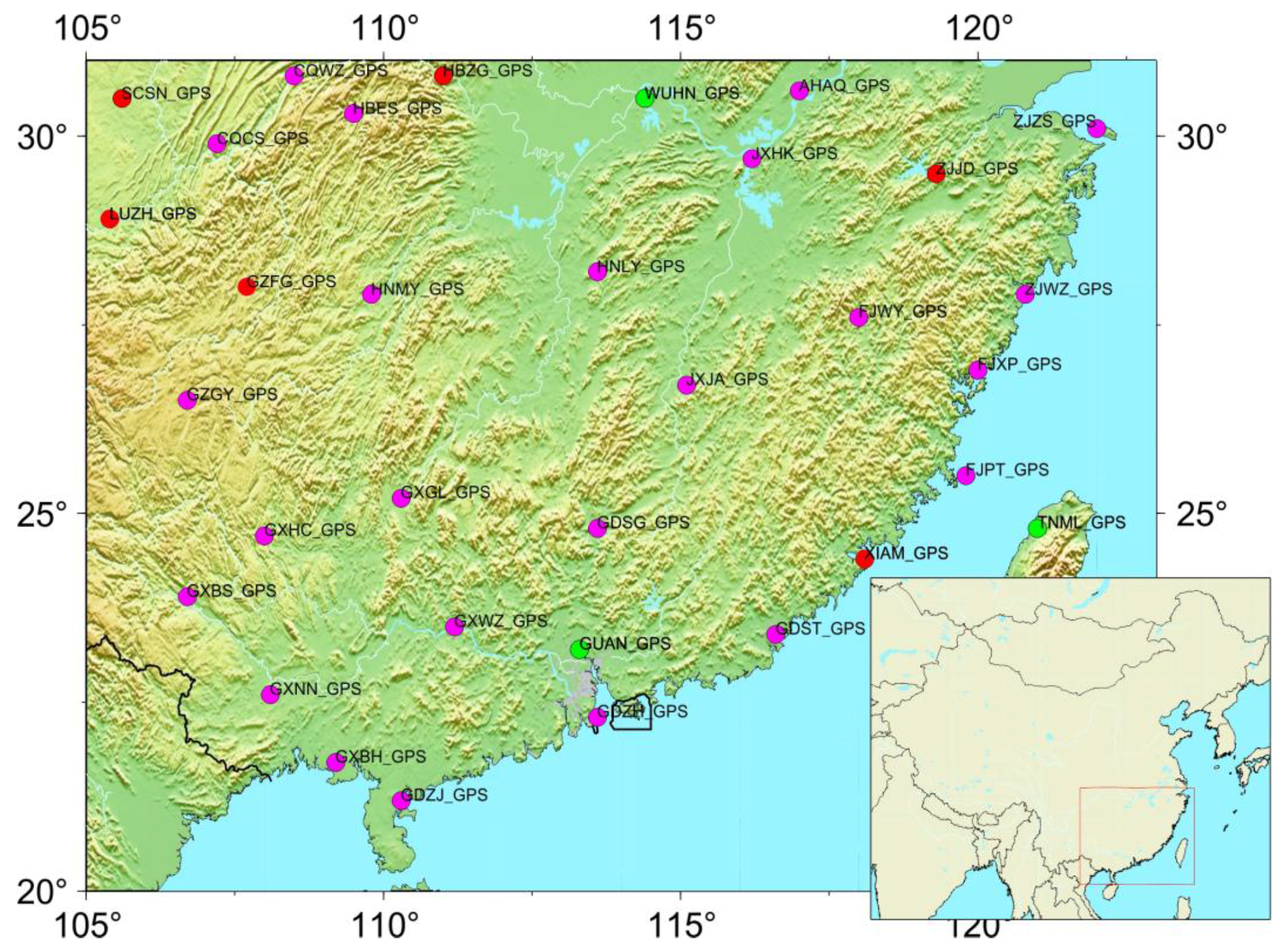
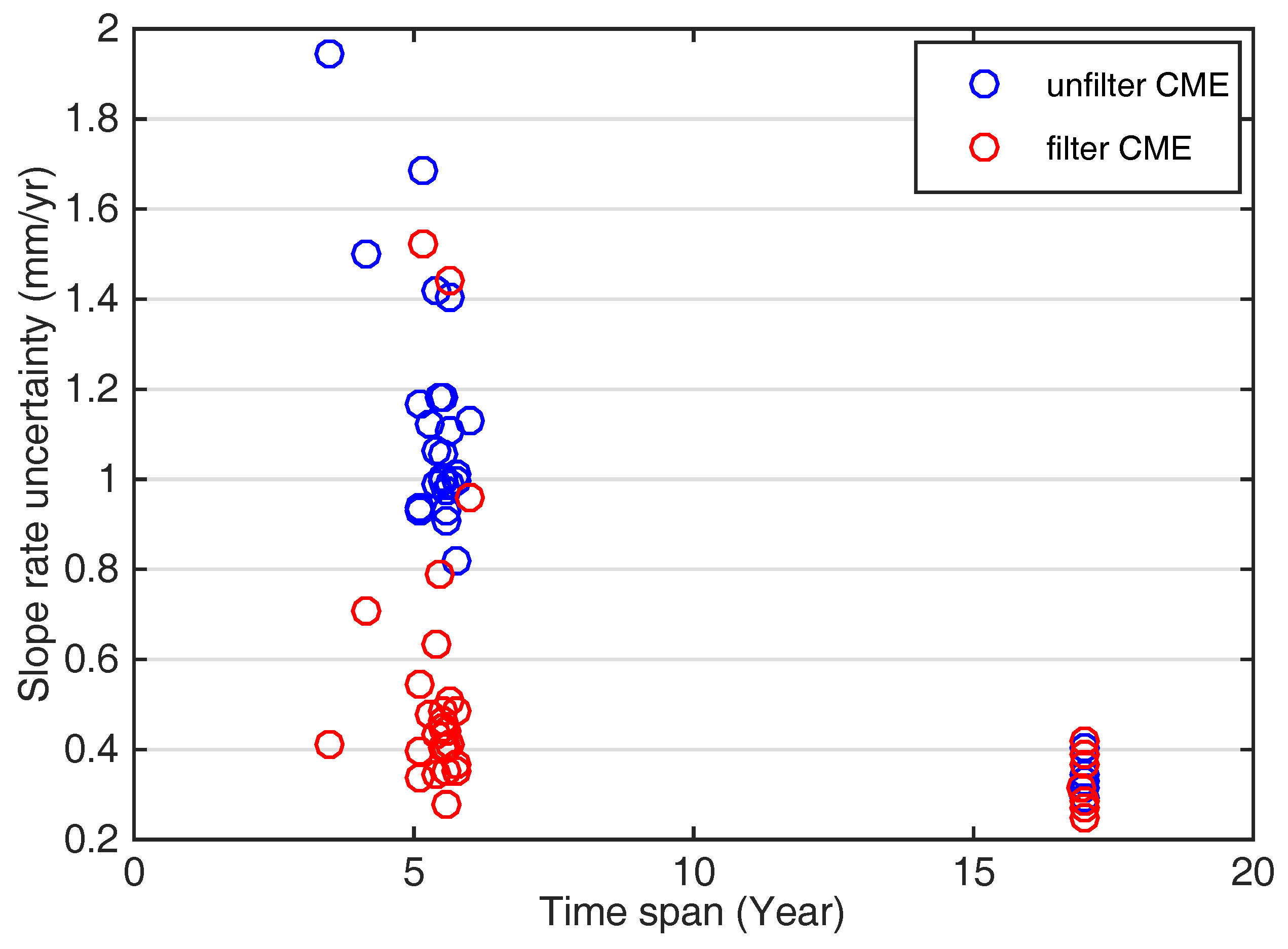
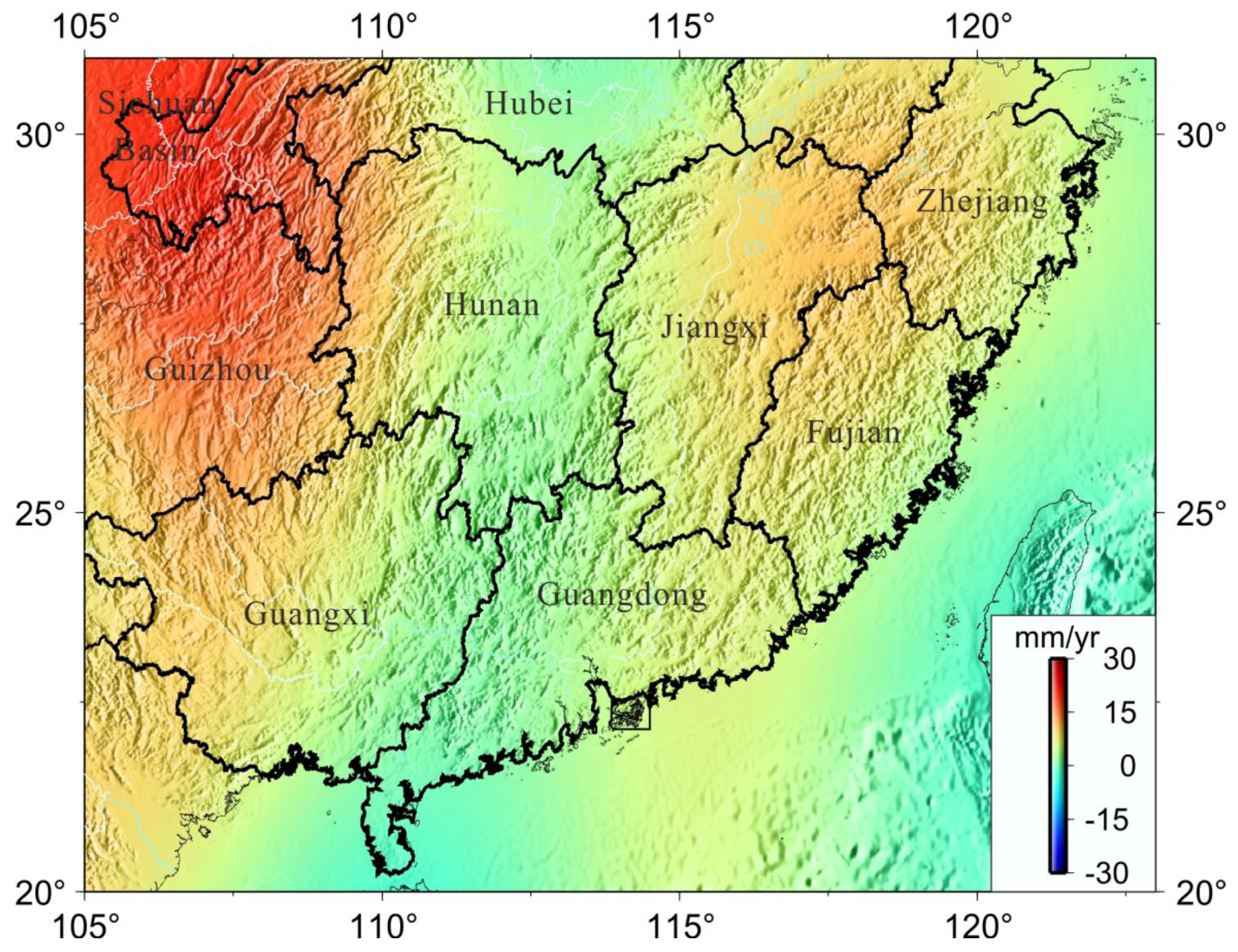

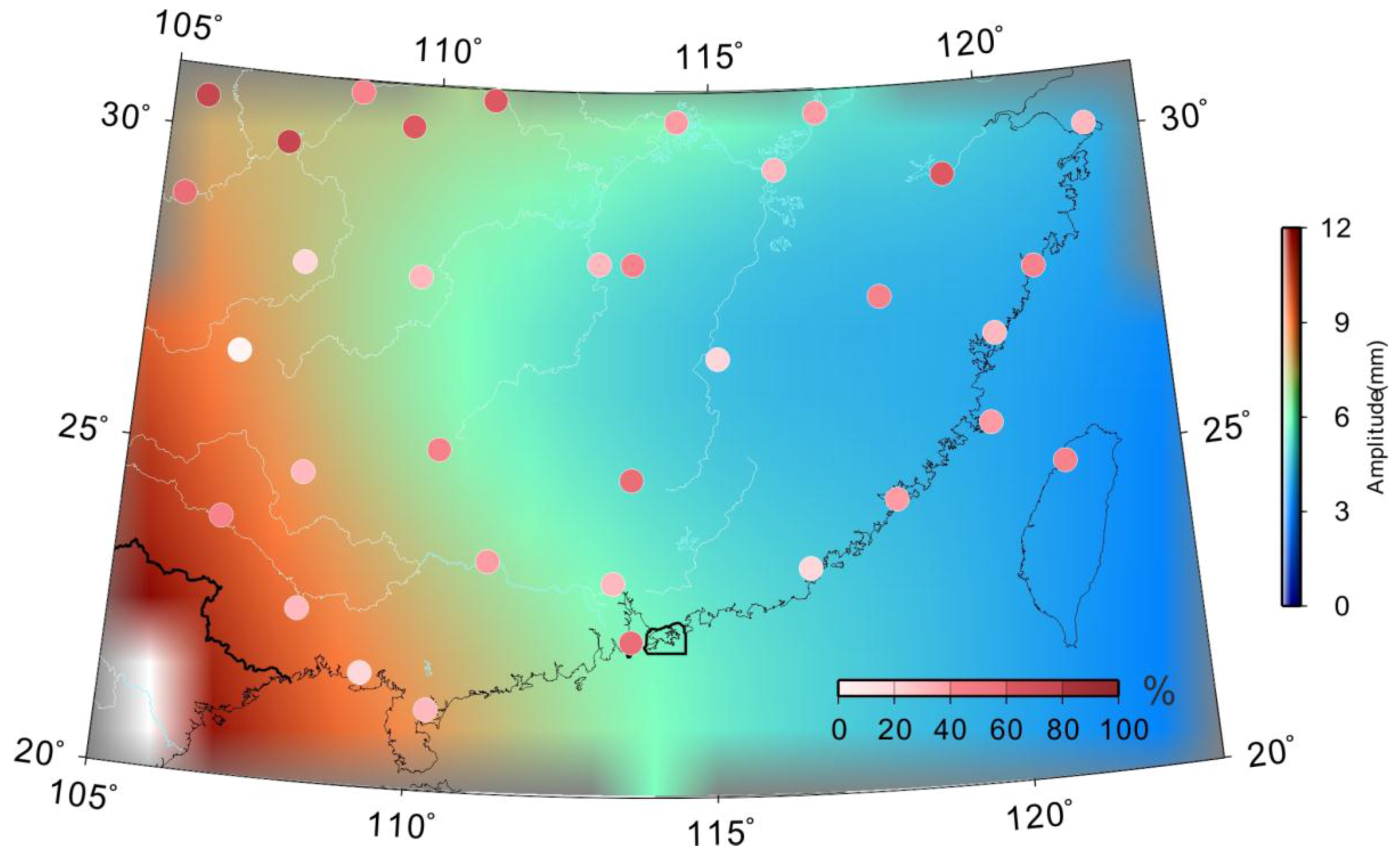
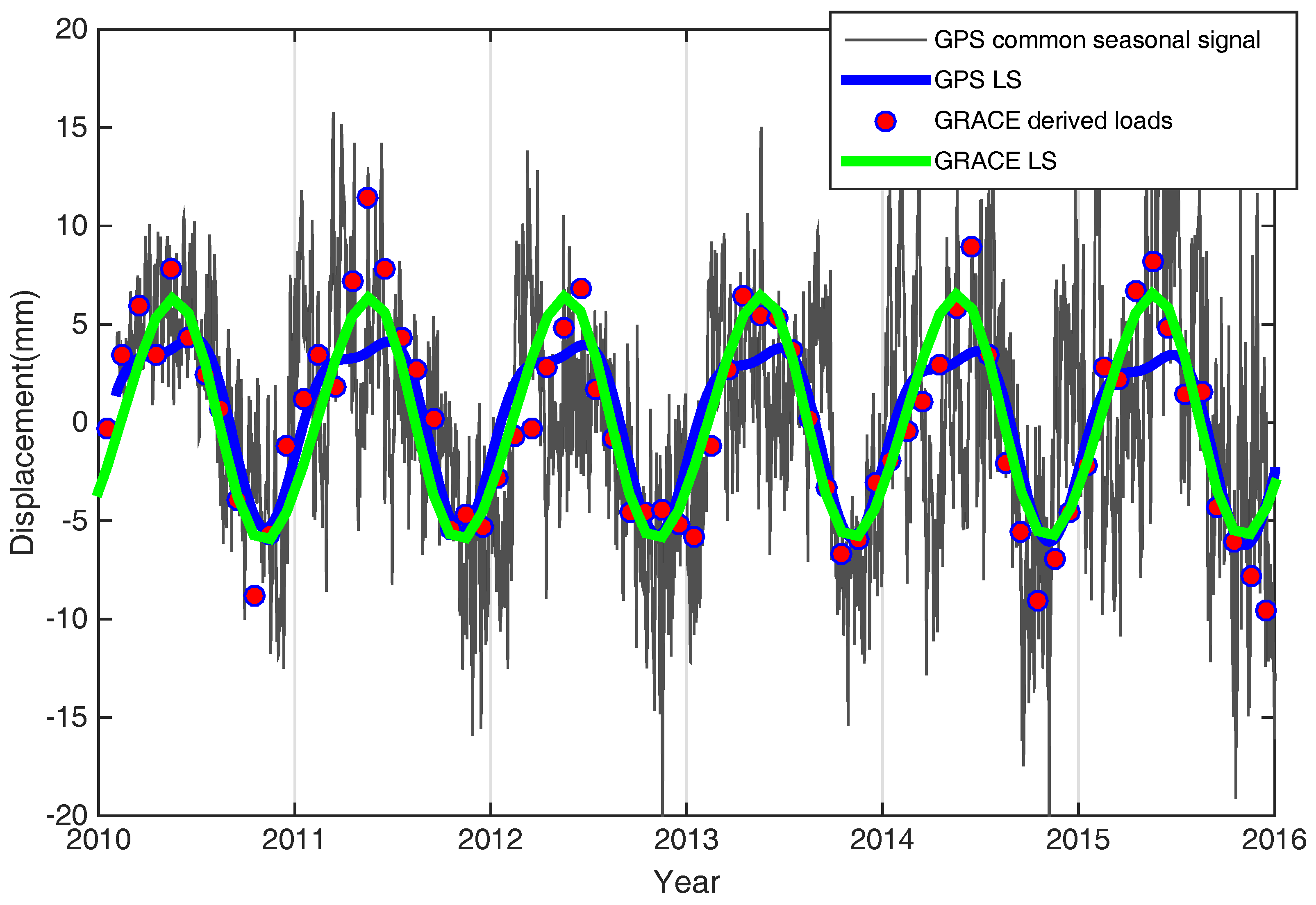
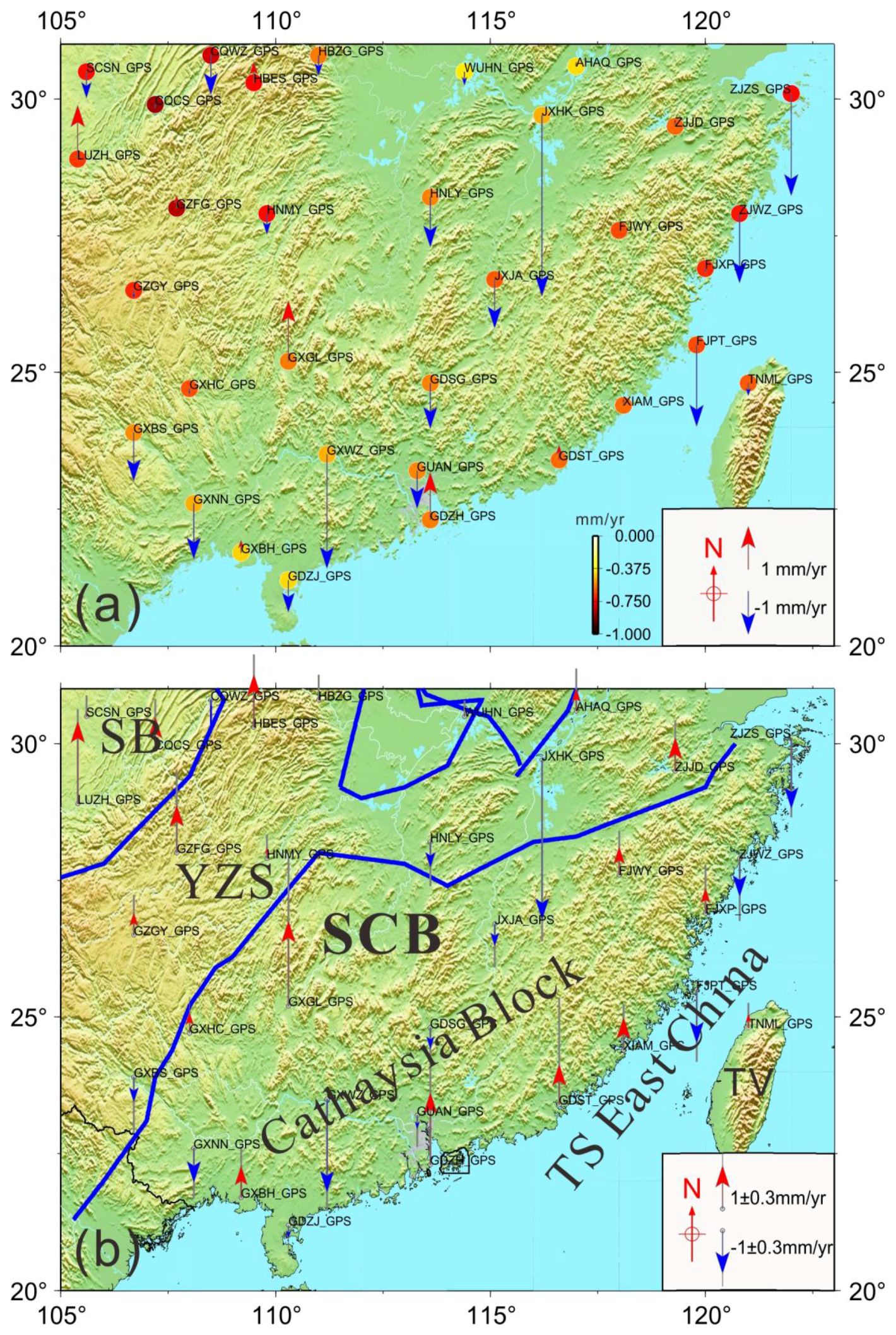
| Site | Lat. (°) | Long. (°) | Duration | GPS-Derived Vertical Velocity (mm/year) | GRACE-Modeled Uplift (mm/year) | Tectonic Vertical Rate (mm/year) | WRMS Reduction (%) |
|---|---|---|---|---|---|---|---|
| AHAQ | 117.0 | 30.6 | 2010–2016 | 0.101 ± 0.447 | −0.424 ± 0.067 | 0.525 ± 0.452 | 35 |
| CQCS | 107.2 | 29.9 | 2010–2016 | −0.092 ± 0.400 | −0.846 ± 0.056 | 0.753 ± 0.404 | 74 |
| CQWZ | 108.5 | 30.8 | 2010–2016 | −0.918 ± 0.636 | −0.794 ± 0.058 | −0.124 ± 0.639 | 44 |
| FJPT | 119.8 | 25.5 | 2010–2016 | −1.892 ± 0.408 | −0.640 ± 0.049 | −1.252 ± 0.411 | 37 |
| FJWY | 118.0 | 27.6 | 2010–2016 | 0.019 ± 0.352 | −0.642 ± 0.054 | 0.661 ± 0.356 | 43 |
| FJXP | 120.0 | 26.9 | 2010–2016 | −0.097 ± 0.503 | −0.687 ± 0.064 | 0.589 ± 0.507 | 28 |
| GDSG | 113.6 | 24.8 | 2010–2016 | −1.058 ± 0.488 | −0.560 ± 0.056 | −0.498 ± 0.491 | 60 |
| GDST | 116.6 | 23.4 | 2010–2016 | 0.348 ± 1.525 | −0.596 ± 0.067 | 0.944 ± 1.526 | 15 |
| GDZH | 113.6 | 22.3 | 2010–2016 | 1.112 ± 0.631 | −0.568 ± 0.057 | 1.680 ± 0.633 | 53 |
| GDZJ | 110.3 | 21.2 | 2010–2016 | −0.740 ± 0.346 | −0.429 ± 0.058 | −0.311 ± 0.351 | 27 |
| GUAN | 113.3 | 23.2 | 1999–2016 | −0.881 ± 0.388 | −0.553 ± 0.062 | −0.328 ± 0.393 | 28 |
| GXBH | 109.2 | 21.7 | 2010–2016 | 0.287 ± 0.433 | −0.441 ± 0.035 | 0.728 ± 0.434 | 12 |
| GXBS | 106.7 | 23.9 | 2010–2016 | −1.122 ± 0.709 | −0.542 ± 0.062 | −0.580 ± 0.712 | 46 |
| GXGL | 110.3 | 25.2 | 2010–2016 | 1.413 ± 1.442 | −0.571 ± 0.066 | 1.984 ± 1.443 | 47 |
| GXHC | 108.0 | 24.7 | 2010–2016 | −0.136 ± 0.344 | −0.631 ± 0.081 | 0.495 ± 0.353 | 22 |
| GXNN | 108.1 | 22.6 | 2010–2016 | −1.296 ± 0.338 | −0.493 ± 0.064 | −0.803 ± 0.344 | 22 |
| GXWZ | 111.2 | 23.5 | 2010–2016 | −2.662 ± 0.400 | −0.489 ± 0.073 | −2.173 ± 0.406 | 34 |
| GZFG | 107.7 | 28.0 | 2010–2016 | 0.294 ± 0.787 | −0.822 ± 0.071 | 1.116 ± 0.790 | 11 |
| GZGY | 106.7 | 26.5 | 2010–2016 | −0.177 ± 0.398 | −0.691 ± 0.064 | 0.514 ± 0.403 | 09 |
| HBES | 109.5 | 30.3 | 2010–2016 | 0.486 ± 0.442 | −0.748 ± 0.064 | 1.234 ± 0.447 | 64 |
| HBZG | 111.0 | 30.8 | 2010–2016 | −0.469 ± 0.464 | −0.571 ± 0.077 | 0.101 ± 0.470 | 67 |
| HNLY | 113.6 | 28.2 | 2010–2016 | −1.161 ± 0.411 | −0.559 ± 0.049 | −0.602 ± 0.413 | 46 |
| HNMY | 109.8 | 27.9 | 2010–2016 | −0.482 ± 0.277 | −0.734 ± 0.053 | 0.251 ± 0.282 | 26 |
| JXHK | 116.2 | 29.7 | 2010–2016 | −4.210 ± 0.486 | −0.493 ± 0.068 | −3.717 ± 0.491 | 20 |
| JXJA | 115.1 | 26.7 | 2010–2016 | −1.134 ± 0.476 | −0.618 ± 0.055 | −0.516 ± 0.479 | 15 |
| LUZH | 105.4 | 28.9 | 1999–2016 | 1.256 ± 0.251 | −0.668 ± 0.072 | 1.924 ± 0.261 | 55 |
| SCSN | 105.6 | 30.5 | 2010–2016 | −0.607 ± 0.350 | −0.726 ± 0.073 | 0.119 ± 0.357 | 73 |
| TNML | 121.0 | 24.8 | 1999–2016 | −0.300 ± 0.240 | −0.619 ± 0.065 | 0.319 ± 0.248 | 40 |
| WUHN | 114.4 | 30.5 | 1999–2016 | −0.321 ± 0.271 | −0.403 ± 0.051 | 0.081 ± 0.276 | 39 |
| XIAM | 118.1 | 24.4 | 1999–2016 | 0.170 ± 0.283 | −0.592 ± 0.059 | 0.762 ± 0.289 | 38 |
| ZJJD | 119.3 | 29.5 | 2010–2016 | 0.178 ± 0.364 | −0.601 ± 0.068 | 0.779 ± 0.371 | 67 |
| ZJWZ | 120.8 | 27.9 | 2010–2016 | −1.616 ± 0.547 | −0.719 ± 0.055 | −0.897 ± 0.550 | 42 |
| ZJZS | 122.0 | 30.1 | 2010–2016 | −2.380 ± 0.180 | −0.738 ± 0.058 | −1.642 ± 0.189 | 27 |
© 2017 by the authors. Licensee MDPI, Basel, Switzerland. This article is an open access article distributed under the terms and conditions of the Creative Commons Attribution (CC BY) license (http://creativecommons.org/licenses/by/4.0/).
Share and Cite
He, M.; Shen, W.; Pan, Y.; Chen, R.; Ding, H.; Guo, G. Temporal–Spatial Surface Seasonal Mass Changes and Vertical Crustal Deformation in South China Block from GPS and GRACE Measurements. Sensors 2018, 18, 99. https://doi.org/10.3390/s18010099
He M, Shen W, Pan Y, Chen R, Ding H, Guo G. Temporal–Spatial Surface Seasonal Mass Changes and Vertical Crustal Deformation in South China Block from GPS and GRACE Measurements. Sensors. 2018; 18(1):99. https://doi.org/10.3390/s18010099
Chicago/Turabian StyleHe, Meilin, Wenbin Shen, Yuanjin Pan, Ruizhi Chen, Hao Ding, and Guangyi Guo. 2018. "Temporal–Spatial Surface Seasonal Mass Changes and Vertical Crustal Deformation in South China Block from GPS and GRACE Measurements" Sensors 18, no. 1: 99. https://doi.org/10.3390/s18010099







